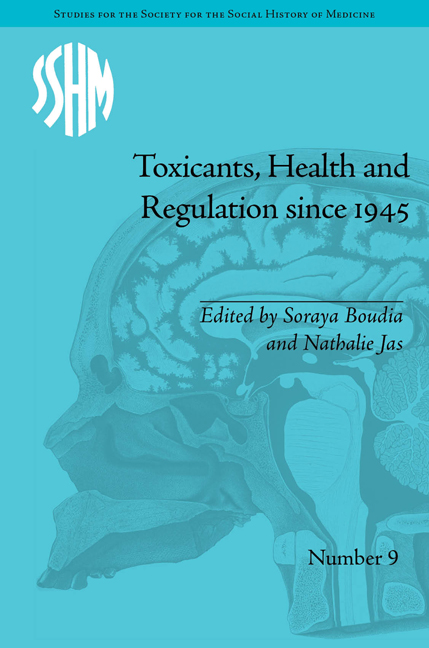Book contents
- Frontmatter
- Contents
- Acknowledgements
- List of Figures and Tables
- List of Contributors
- Introduction
- 1 The Cold War Over the Worker's Body: Cross-National Clashes Over Maximum Allowable Concentrations in the Post-World War II Era
- 2 Adapting To ‘Reality’: The Emergence of an International Expertise On Food Additives and Contaminants in the 1950s and Early 1960s
- 3 From Threshold to Risk: Exposure to Low Doses of Radiation and its Effects On Toxicants Regulation
- 4 ‘License To Expose’? Occupational Exposure Limits, Scientific Expertise and State in Contemporary France
- 5 Chemical Infrastructures of the St Clair River
- 6 Managing an Everlastingly Polluted World: Food Policies And Community Health Actions in the French West Indies
- 7 Chernobyl Empowerment? Exporting ‘Participatory Governance’ to Contaminated Territories
- Notes
- Index
4 - ‘License To Expose’? Occupational Exposure Limits, Scientific Expertise and State in Contemporary France
- Frontmatter
- Contents
- Acknowledgements
- List of Figures and Tables
- List of Contributors
- Introduction
- 1 The Cold War Over the Worker's Body: Cross-National Clashes Over Maximum Allowable Concentrations in the Post-World War II Era
- 2 Adapting To ‘Reality’: The Emergence of an International Expertise On Food Additives and Contaminants in the 1950s and Early 1960s
- 3 From Threshold to Risk: Exposure to Low Doses of Radiation and its Effects On Toxicants Regulation
- 4 ‘License To Expose’? Occupational Exposure Limits, Scientific Expertise and State in Contemporary France
- 5 Chemical Infrastructures of the St Clair River
- 6 Managing an Everlastingly Polluted World: Food Policies And Community Health Actions in the French West Indies
- 7 Chernobyl Empowerment? Exporting ‘Participatory Governance’ to Contaminated Territories
- Notes
- Index
Summary
Introduction
In France the asbestos affair created a wide audience for occupational health issues, which usually receive little public attention. After 1995, with the spotlight on this affair, it appeared that one of the instruments framing the use of asbestos was the setting of Occupational Exposure Limits (OELs). These limits, representing the exposure thresholds not to be exceeded in professional use of a toxin, were set for asbestos at the end of the 1970s. However, although they protected workers from certain pathologies, they failed to protect them from the risk of cancer, as asbestos is a carcinogen without a threshold. OELs have, at worst, been perceived and denounced as licenses (for employers) to expose (workers to risks), and therefore as the cause of delays in the implementation of preventive actions in industry.
OELs, used in many countries to manage certain occupational risks, highlight the contradictions running through all occupational health policies, for while they are supposed to protect workers from risks of exposure to certain toxins, they also have to avoid subjecting industry to excessive constraints. This fundamentally contradictory dimension of occupational health policies is problematical, especially for contemporary democratic states that have the objective of protecting all their citizens from health hazards. Problems of this nature, concerning all occupational health policies, are particularly evident in the case of OELs, for the very fact of setting these values brings to the fore otherwise largely invisible contradictions.
- Type
- Chapter
- Information
- Toxicants, Health and Regulation since 1945 , pp. 89 - 102Publisher: Pickering & ChattoFirst published in: 2014



